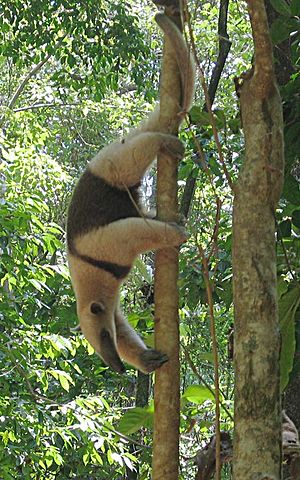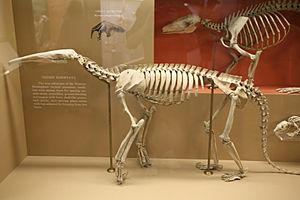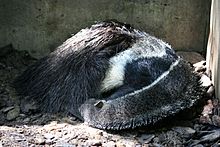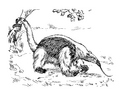Anteater facts for kids
Quick facts for kids Anteaters |
|
|---|---|
 |
|
| Northern Tamandua (Tamandua mexicana) |
|
| Scientific classification | |
| Kingdom: | |
| Phylum: | |
| Class: | |
| Superorder: | |
| Order: | |
| Suborder: |
Vermilingua
Illiger, 1811
|
| Families | |
|
Cyclopedidae |
|
Anteaters are amazing mammals found in South America and Central America. They belong to a special group called Vermilingua.
These unique animals are famous for eating ants and termites. They use their long, sharp claws to open insect nests. Then, they quickly lick up their meal with a super long, sticky tongue. This tongue can be up to 60 centimeters (about 2 feet) long!
Discovering Anteaters: A Look at Their Past
Anteaters are part of a very old group of mammals. This group once lived only in South America. At that time, South America was like an island, separate from other continents. Other animals in this group are sloths and armadillos.
For a long time, people thought anteaters were related to aardvarks and pangolins. This was because they look similar and eat the same foods. But scientists now know these animals are not closely related. They just developed similar features because they live in similar ways. This is called convergent evolution. All of them have strong front claws, long tongues, and snouts without teeth. These features help them break into termite mounds and eat insects.
What Makes an Anteater Special?

All anteaters have long snouts and a very thin tongue. Their tongue can stretch out longer than their head! Their mouths are shaped like tubes and have lips, but no teeth.
They use their big, curved front claws to break open ant and termite nests. These claws also help them defend themselves. Their thick, long fur protects them from insect bites. All anteater types, except the giant anteater, have a long tail that can grab onto things. This is called a prehensile tail.
How Anteaters Live and Behave
Anteaters usually live alone. They are ready to protect their home areas, which can be quite large. A male anteater usually does not go into another male's area. But males often visit the areas of female anteaters. If two anteaters argue over land, they might make noises or swat at each other. Sometimes, one might even sit on or ride the back of the other!
Anteaters do not see very well. But they have an amazing sense of smell. Most species use their smell to find food and stay safe. Scientists think their hearing is also good.
Anteaters have a lower body temperature than most mammals. It usually stays between 33 and 36 degrees Celsius (91 to 97 degrees Fahrenheit). They can also handle bigger changes in their body temperature. They likely keep their bodies cool when resting. Then they warm up when they are looking for food.
Raising Young Anteaters
Male anteaters are a bit bigger and stronger than females. They also have wider heads and necks. Usually, a female anteater has one baby at a time. Twins can happen but are very rare. Because of their large front claws, mothers cannot hold their newborns. So, they carry their babies on their backs until they can take care of themselves.
What and How Anteaters Eat
Anteaters are experts at eating small insects. Each type of anteater prefers different insects. Smaller anteaters eat insects that live on small tree branches. Larger anteaters can break into the tough nests of insects on the ground.
To avoid being bitten or stung by insects, anteaters eat very quickly. They lick up many ants and termites as fast as possible. An anteater usually spends only about a minute at one nest before moving to another. A giant anteater might visit up to 200 nests in an hour! This helps it eat the thousands of insects it needs.
The anteater's tongue has thousands of tiny hooks called filiform papillae. These hooks, along with lots of sticky saliva, help hold the insects. The anteater moves its jaws from side to side to help swallow and move its tongue. The tongue is attached to its chest bone and moves super fast, flicking up to 150 times per minute!
An anteater's stomach is like a bird's gizzard. It has tough folds and strong muscles to grind up the insects. Small amounts of sand and dirt that the anteater swallows also help with digestion.
Where Anteaters Live
Their Range
Silky anteaters and northern tamanduas live as far north as southeastern Mexico. Giant anteaters can be found as far north as Central America. Southern tamanduas live south to Uruguay. The areas where all species live, except the northern tamandua, overlap in eastern Brazil.
Anteaters lived only in South America for a long time. This was during the Cenozoic Era, when South America was an island continent. But about three million years ago, a land bridge called the Isthmus of Panama formed. This allowed anteaters to move into Central America. This event is known as the Great American Interchange.
Their Homes
Anteaters live in many different places. These include dry tropical forests, rainforests, grasslands, and savannas.
The silky anteater (Cyclopes didactylus) lives mostly in trees. The tamanduas are more flexible. They find food both on the ground and in trees. They often live in dry forests near streams and lakes. The giant anteater (Myrmecophaga tridactyla) lives almost entirely on the ground in savannas.
The two anteaters in the genus Tamandua are the southern (Tamandua tetradactyla) and northern tamanduas (Tamandua mexicana). They are much smaller than the giant anteater. They also live differently, spending most of their time in trees. They live in the thick, old forests of South and Central America. Their fur is usually yellowish-white with a wide black stripe along their sides.
The silky anteater (Cyclopes didactylus) lives in the warmest parts of South and Central America. It is about the size of a cat. It is usually yellowish and lives only in trees.
See also
 In Spanish: Vermilingua para niños
In Spanish: Vermilingua para niños







